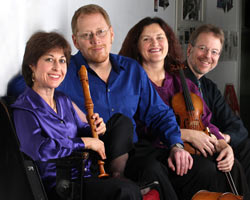|
Symphony
FROM THE NEW WORLD TO THE OLD WORLD
by Peter Lert
Saturday, June 14, 2025
Chamber
MC2 DUO RECITAL CLOSES 222'S SEASON
by Terry McNeill
Saturday, June 14, 2025
Choral and Vocal
CANTIAMO SONOMA'S LUSCIOUS A CAPELLA SINGING IN SEASON ENDING CONCERT
by Pamela Hicks Gailey
Sunday, June 8, 2025
Symphony
SRS SEASON ENDS WITH RESOUNDING TA-TA-TA-BANG
by Terry McNeill
Sunday, June 1, 2025
Symphony
YOUTHFUL VIRTUOSITY ON DISPLAY AT USO'S MAY CONCERTS
by Peter Lert
Saturday, May 17, 2025
Symphony
MYSTICAL PLANETS AND LIVELY GERSHWIN ORTIZ AT FINAL SRS CONCERT
by Peter Lert
Sunday, May 4, 2025
Symphony
VSO'S CONCERT MUSIC OF TIME, MUSIC OF PLACE
by Peter Lert
Sunday, April 27, 2025
VOCAL ELEGANCE AND FIRE AT THE 222'S RECITAL APRIL 26
by Pamela Hicks Gailey
Saturday, April 26, 2025
CANTIAMO SONOMA SINGS AN INSPIRED GOOD FRIDAY MOZART REQUIEM CONCERT
by Pamela Hicks Gailey
Friday, April 18, 2025
DRAMATIC SHOSTAKOVICH SYMPHONY CLOSES PHILHARMONIC'S 25TH SEASON
by Terry McNeill
Sunday, April 13, 2025
|
 |
 Musica Pacifica |
BAROQUE MUSIC AT ITS BEST
by Joanna Bramel Young
Sunday, September 7, 2008
On Sept. 5, the Sonoma Classical Music Society presented the baroque chamber ensemble Musica Pacifica in a delightful concert. Recorder virtuoso Judith Linsenberg (a Bay Area resident and graduate of Stanford’s early music program), brilliant baroque violinist Elizabeth Blumenstock (of American Bach Soloists and Philharmonia Baroque fame), baroque cellist and viola da gambist David Morris (one of the Bay Area’s finest baroque specialists), and harpsichordist Yuko Tanaka (replacing Charles Sherman) performed a varied program of early Italian works, as well as pieces by Bach, Telemann, Purcell, Domenico Scarlatti, Veracini, and Rameau.
Sonoma’s Burlingame Hall is not an ideal venue for concerts, and on this hot evening the air conditioner was so loud that it had to be turned off during the concert, leaving both the performers and audience sweltering. With no raised stage, it was difficult to see the performers, and the lighting was dim. Concert goers were also on their own trying to find their cars in the dark parking lot after the event. However, the performers rose to the challenge, and put on an excellent concert, in spite of having just gotten off a plane from Seattle.
In the first piece, a Vivaldi Concerto in D Major, Linsenberg performed on the voice flute, a recorder almost as large as the tenor recorder, but in the key of D (the tenor is in C). The voice flute was a popular instrument in the 18th century, as it plays in the same range as the human singing voice. Especially notable was Blumenstock’s recently acquired violin line, which had an exceptionally sweet tone. This violin was the gift of a Philharmonia Baroque patron, and after trying many instruments throughout the United States, she settled on one she thought she may have played (and fallen in love with) years earlier. It had belonged to a former Metropolitan Opera orchestra violinist who had long ago let her try his fiddle, an Andrea Guarneri built in Cremona in 1660.
The performers exhibited impressive technique. This reviewer, a recorder player, was especially impressed at the brilliant and expressive work of Linsenberg on five different recorders. On instruments with no keys, she was able to play with astonishing speed and sensitivity. In one piece, the Rameau Suite from “Les Indes Galantes,” the recorder and violin played in unison – perfectly matched in intonation and dynamics. Elizabeth Blumenstock had to match the soft recorder perfectly, and did to great effect.
The 16th century Italian composers Castello, Falconiero, and Rossi are favorites for the recorder performer – brilliant short works and passionate at the same time. The renaissance ornaments flew fast and furiously in these pieces, demonstrating how sophisticated recorder technique was in the 16th century. Another lovely piece was a Bach organ trio that had been arranged for three solo instruments: gamba, alto recorder, and violin, with harpsichord accompaniment. Bach created three solo lines on the organ – one for each hand and one for the feet. He would often arrange his own ensemble works into organ trios, so Musica Pacifica simply reversed the process.
One of the more sensitive performances of the evening was the “Scottish” movement from Veracini’s Sonata in A Major. One rarely encounters use of a slow, sentimental Scottish melody by an Italian baroque composer; but Veracini wrote a set of imaginative variations on one in the Italian manner, returning to the simple tune near the end of the movement. It was played with elegance by Blumenstock and Tanaka.
|
